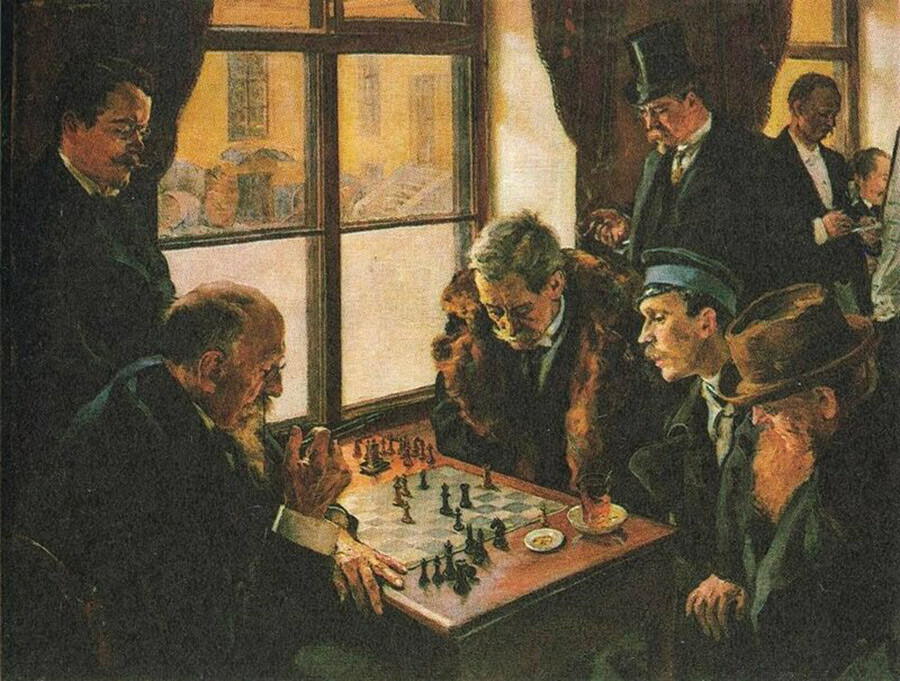5 facts about ‘Dominique’ - the FIRST ever Russian restaurant-cafe

Nicholas I gave the blessing
 Facade of the building located Nevsky prospect, 24 with the signage of the Cafe Dominic
Facade of the building located Nevsky prospect, 24 with the signage of the Cafe Dominic
Before the start of the 19th century, the only places you could have dinner in Russia were small taverns and pubs. In 1840, Swiss confectioner Dominique Ritz-a-Porta decided to take things to a new level and open a St. Petersburg cafe, where you could have a hearty meal and wash it down with a coffee. His application was considered at the highest level – in the court of Tsar Nicholas I, who personally signed a decree allowing it to be opened; the Senate followed suit the following year and, in 1841, ‘Dominique’, the first ever restaurant-cafe in Russia, opened to the public at Nevsky Prospect, 24.
Eating kulebyaki & playing billiards

The menu delighted patrons with variety: “Tea, coffee, chocolate, gluhwein, steak…” There was also a variety of pirogi, meat jelly, shchi, porridge, fried meats, bear – and cake for dessert. As writer Anton Chekhov wrote to his brother, Mikhail: “We took the boat out on the Neva, which left an impression. We disembarked and headed to Dominique’s, where we had some rasstegai, shots and coffee for 60 kopecks…” However, the main attraction was the kulebyaki, which poet Nikolai Agnivtsev, a regular, wrote an entire poem about.
Nice cuisine and tolerable prices made ‘Dominique’ a real hit with the crowds: students and writers, artists and civil servants – even swindlers of every ilk, working their craft on the Nevsky – everyone seemed to be a patron. Many would spend entire days in the smoked up, noisy main hall, perusing the latest news, playing billiards, checkers, dominos or card games.

Occasionally, the penchant for fun times would even lead to tragic outcomes. Writer Fyodor Dostoyevsky once came for dinner and took a liking to dominos. Sadly for him, his opponent – who swore the game was “completely innocent” - turned out to be a hustler. That evening, Dostoyevsky ended up parting with the last 100 rubles of the 1,000 he’d received that morning.
Regulars referred to themselves as “Dominicans”: writer Mikhail Saltykov-Shchedrin left behind numerous memories of the place in his essays. For instance, in his ‘Diary of a Country Man in St. Petersburg’, he writes: “I’ll say this – should you order a ten-kopecks’ worth of kulebyaki at Domonique’s – you’ll get ten-kopecks’ worth of fire – and I’m right! Except you’ll also get frozen whitefish in your kulebyaka – and that’s not good at all!”
‘Dominique’ hosted the first chess tournaments
 Gugo Bachmanson. Chess game. Cafe Dominique in Petersburg. 1909
Gugo Bachmanson. Chess game. Cafe Dominique in Petersburg. 1909
Chess players would also gather at the restaurant. Mikhail Chigorin, one of the forefathers of Russian chess, recalled that playing in the stuffy, smoky atmosphere required nerves of steel and a certain mental toughness. Alexander Alyokhin, Emanuel Schiffers and Evgeny Znosko-Borovsky frequented the establishment: playing them would cost 20 kopecks, which went toward renting a space. Some students even managed to make a living playing chess: they’d be placing bets from the morning till the evening (that same 20 kopecks) and earned their dinner that way. Meanwhile, the first chess tournaments were held there in 1876.
Depicted in paintings
 Vladimir Makovsky. Scene at the cafe Dominique in St. Petersburg, Russian Empire (Nevsky prospect, 24). 1897
Vladimir Makovsky. Scene at the cafe Dominique in St. Petersburg, Russian Empire (Nevsky prospect, 24). 1897
‘Dominique’ would serve up to 1,500 customers on a daily basis, although, aside from the Nevsky cafe, St. Petersburg was starting to see other similar establishments pop up. Still, no one boasted the type of atmosphere the place was known for, which served to attract painters. Scenes from daily life in the cafe appeared in the paintings of Vladimir Makovsky, Ilya Repin and Gugo Bakmanson, among others.
Closed after the Revolution
 Ilya Repin At Dominique. 1887, State Russian Museum
Ilya Repin At Dominique. 1887, State Russian Museum
Prior to 1907, ‘Dominique’ belonged to the Ritz-a-Porta family, passing on to stakeholders after the confectioner’s death. After the 1917 Bolshevik Revolution, the chic establishment closed, leaving behind only photographs, paintings and memories of its customers. But, the name took on a life of its own: In 1928, in Paris, emigrant Lev Aaranson opened a restaurant and also called it ‘Dominique’. Ivan Bunin, Nadezhda Teffi, Mark Aldanov and many others were among its clientele. Regular customers, likewise, adopted the moniker of “Dominicans” and the owner – “Dominique”.

